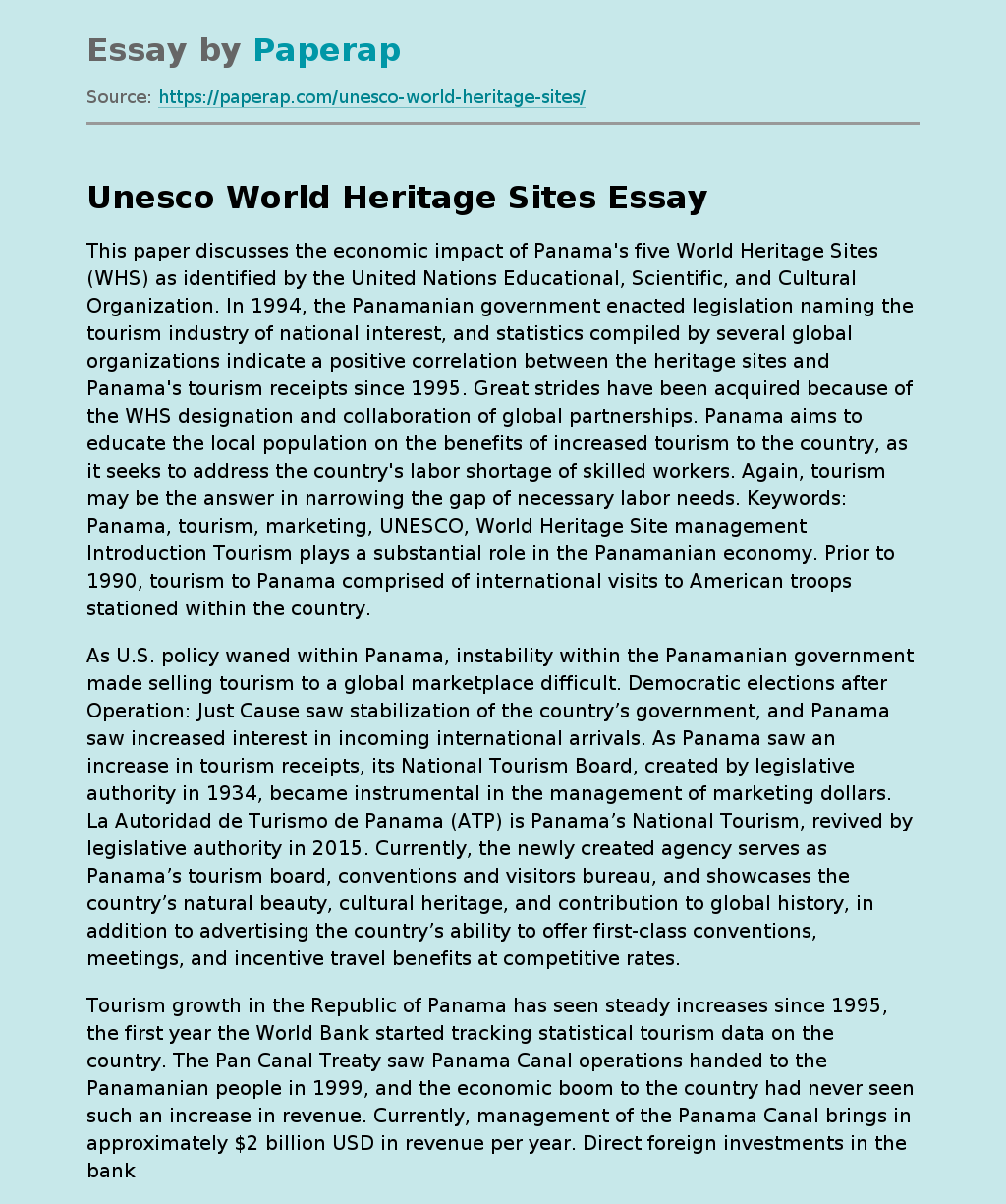Unesco World Heritage Sites
This paper discusses the economic impact of Panama’s five World Heritage Sites (WHS) as identified by the United Nations Educational, Scientific, and Cultural Organization. In 1994, the Panamanian government enacted legislation naming the tourism industry of national interest, and statistics compiled by several global organizations indicate a positive correlation between the heritage sites and Panama’s tourism receipts since 1995. Great strides have been acquired because of the WHS designation and collaboration of global partnerships. Panama aims to educate the local population on the benefits of increased tourism to the country, as it seeks to address the country’s labor shortage of skilled workers.
Again, tourism may be the answer in narrowing the gap of necessary labor needs. Keywords: Panama, tourism, marketing, UNESCO, World Heritage Site management Introduction Tourism plays a substantial role in the Panamanian economy. Prior to 1990, tourism to Panama comprised of international visits to American troops stationed within the country.
As U.S. policy waned within Panama, instability within the Panamanian government made selling tourism to a global marketplace difficult.
Democratic elections after Operation: Just Cause saw stabilization of the country’s government, and Panama saw increased interest in incoming international arrivals. As Panama saw an increase in tourism receipts, its National Tourism Board, created by legislative authority in 1934, became instrumental in the management of marketing dollars. La Autoridad de Turismo de Panama (ATP) is Panama’s National Tourism, revived by legislative authority in 2015. Currently, the newly created agency serves as Panama’s tourism board, conventions and visitors bureau, and showcases the country’s natural beauty, cultural heritage, and contribution to global history, in addition to advertising the country’s ability to offer first-class conventions, meetings, and incentive travel benefits at competitive rates.
Tourism growth in the Republic of Panama has seen steady increases since 1995, the first year the World Bank started tracking statistical tourism data on the country. The Pan Canal Treaty saw Panama Canal operations handed to the Panamanian people in 1999, and the economic boom to the country had never seen such an increase in revenue. Currently, management of the Panama Canal brings in approximately $2 billion USD in revenue per year. Direct foreign investments in the banking, hospitality, and construction industries brought revenues of approximately $1600 million USD in 2017. These figures rank Panama 2nd for economic strength and competition and 11th in overall wealth among its Latin American counterparts. Additionally, the United Nations Educational, Scientific, and Cultural Organization has identified five World Heritage Sites (WHS) within the country as natural and cultural heritage sites of significance. Since 1980, these five locations have helped increase tourism to Panama, as the tourism industry makes an impact to the country’s gross domestic product.
Literature Review UNESCO fulfills its purpose, as set forth in the Convention’s preamble, to “maintain, increase, and diffuse knowledge.” When tourists from all walks of life travel to World Heritage Sites, they leave with a heightened appreciation and awareness of the benefits of culture, history, and heritage. Governments also benefit from the increase in tourism revenue, the availability of external financial assistance, and the opportunity to preserve their heritage and attract experts. While the purpose is to maintain and preserve areas of cultural significance to the world, signing governments accepting the designation accept the responsibility for the process of keeping artifacts and heritage, which qualifies the area for inclusion open for display – exacting and unencumbered by future construction or innovation while capitalizing on the prestige of the WHS designation.
What is more, WHS designation attracts donors and sponsorships to assist in the conservation and preservation aspect of maintaining architecture, cultural heritage, whether tangible or intangible, lifestyle, and language, potentially benefitting countries with designated WHS. In previous years, blighted areas within the country experienced high rates of crime, including drug and human trafficking in the WHS areas. Casco Viejo, a WHS first identified in 1997, saw investment and a preservation movement to reconstruct and conserve Spanish and Dutch architecture, the reason for the designation. The once dangerous area is home to boutique hotels and lodging, museums, and trendy eateries, catering to international travelers and showcasing the best of Panamanian cuisine. As such, UNESCO’s identification of World Heritage Sites (WHS) in Panama has impacted tourism receipts in the country.
For nearly two decades, Panama has boasted a fairly robust regulatory and incentive framework for the [tourism] industry, one which has been modified over time to promote different segments of the travel and tourism markets. One recent modification was the expansion of the Panama Canal in 2016. The $5.25 billion expansion poises Panama as the only waterway connecting both the Atlantic and Pacific Oceans for trade and tourism travel. Increase in modes of travel have opened new sectors of tourism within the country, as Panama mirrors successful destinations such as the United States and several European countries. Adventure and eco-tourism are on the rise with the vast diversity of topography, climate, and oceans available within a 90-mile stretch across the country. With the steep and steady increase in tourism within the country, Panama suffers from a shortage of qualified, bilingual employees to fill open positions.
According to Panama’s census bureau, El Instituto Nacional de Estatistica y Censo, the labor market saw an increase of 21% at the same time as the previous year. Public education in Panama is one of the worst systems in the world. In 2013, Panama ranked 112 out of 140 countries surveyed on the graduation percentages for primary, middle, and secondary education. Educational and class inequality are a persistent issue that increased revenue within the country has not addressed. Net profits from the operations of the Panama Canal get pooled into the Panamanian treasury. Using this surplus of tourism-related revenue for the bilingual education of an unemployed and underemployed Panamanian population, specifically targeting at-risk communities of displaced and indigenous people, would address the labor shortage in Panama and encourage local and community buy-in for Panama’s fastest-growing industry.
Unesco World Heritage Sites. (2021, Dec 13). Retrieved from https://paperap.com/unesco-world-heritage-sites/

